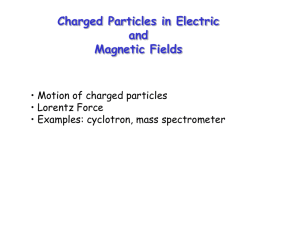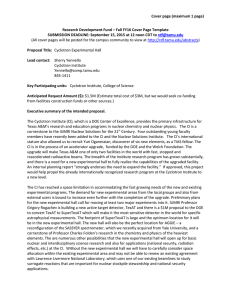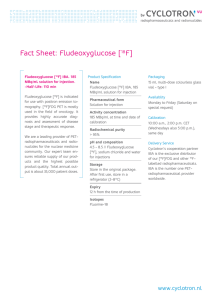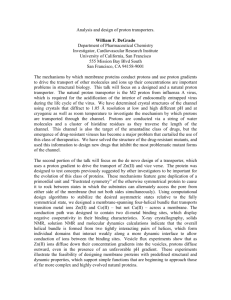Cancer Therapy with Particle Beams
advertisement
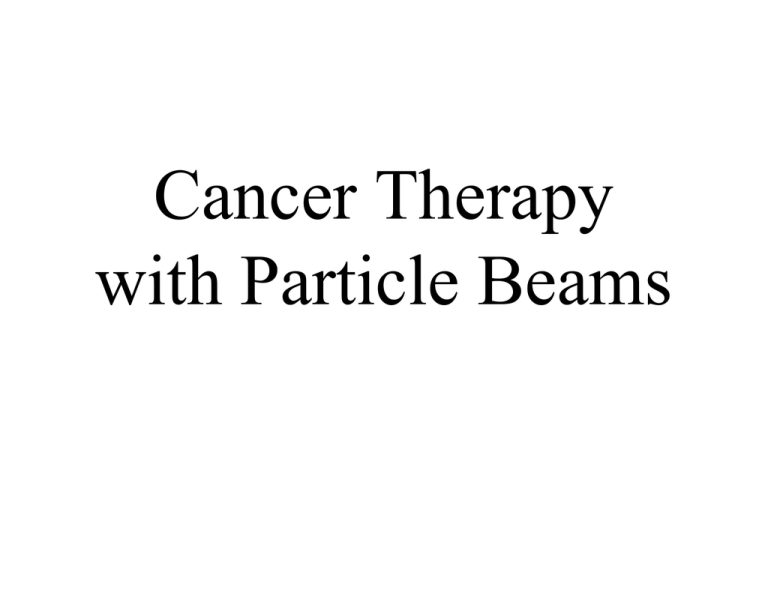
Cancer Therapy with Particle Beams • The potential to use high energy particle beams to treat many types of cancer has been known even before their creation. • The availability of these treatments has been based on 2 main factors: precisely locating the target and the very expensive cost Recognition • 1946- Dr. Robert R. Wilson illustrated in his paper the great potential for proton beams to be used in medicine, specifically for the treatment of certain cancers. His paper was published when cyclotrons were being created which, for the first time, had enough energy to sufficiently penetrate human tissue. • 1948- Dr. R. Wilson’s predictions concerning the interaction of proton beams and tissue were confirmed at the Berkeley Laboratory (later named the Lawrence Berkeley Laboratory after the Lawrence brothers). • The first treatments were performed on pituitary glands at Berkeley. • 1950’s- pituitary gland treatments were successfully duplicated first at Uppsala Sweden and then at the Harvard cyclotron. Benefits of Proton Beam vs. X-ray Beam Radiotherapy • Proton beams can be conformed and controlled more easily and precisely. -magnets vs. lenses • Less dispersion within tissue for proton beams. -Photons interact more directly with the electrons as the beam transfers its kinetic energy to the tissue. • Proton beams leave the protons at the target. -As an added bonus the protons are left behind changing the chemistry of the site. • Bragg Peak-Protons deposit the majority of their ionizing energy at the end of their path. -Termed “Bragg Peak”, this phenomenon is in stark Dr. Robert R. Wilson (1914-2000) • • 1967-Wilson touring, on bicycle, the facility later named the Wilson Synchrotron Laboratory. 1973-Wilson receiving the National Medal of Science from President Nixon Major Achievements: -Headed the Manhattan Project’s Experimental Nuclear Physics Division in Los Alamos during WWII. -Joined Cornell in ‘57. -Designer of High Energy particle accelerators. -First director of Fermilab until ‘78. 1946 Paper: In his 1946 paper he describes the upcoming availability of high energy ion beams and their advantages: “Higher-energy machines are now under construction, however, and the ions from them will in general be energetic enough to have a range in tissue comparable to body dimensions. It must have occurred to many people that the particles themselves now become of considerable therapeutic interest. The object of this paper is to acquaint medical and biological workers with some of the physical properties and possibilities of such rays.”, Dr. Robert Wilson. Bragg Peak • • • This graph from Dr. Wilson’s 1946 paper shows dosage vs. tissue depth. Dosage is proportional to Specific Ionization. As the protons slow, their ability to ionize molecules increases. •Curve 1 shows proton range in tissue as a function of proton energy. •Curve 2 shows specific ionization as a function of residual range in tissue. Other Key Players Lawrence Brothers Ernest Orlando & John H. • E.O.L. invented the cyclotron.-1931 • John Lawrence was the first to treat cancer with a cyclotron. Ernest Orlando Lawrence (1901-58) •Ernest Orlando Lawrence (1901-58) completed his Ph.D. in 1924 at Yale, where he was appointed assistant professor in ‘27. •He soon switched to Berkeley as associate professor where he would head the Radiation Laboratory (Rad Lab). •He produced a series of cyclotrons starting in the ‘30’s. •1931 The first cyclotron was produced by Lawrence and Livingston (a grad. Student at the time) in ‘31. It was 4.5 inches in diameter and used 1800V to produce 80KeV protons. E.O. Lawrence (right) poses with his sixty inch cyclotron •1931 He also produced an 11 inch cyclotron which could supply 1MeV protons. •1932 His 27 inch cyclotron advanced to 3.6MeV. In ‘37 he produced a 37 inch cyclotron. E.O.L. at the controls of his 37 inch cyclotron •1939 His 60 inch cyclotron could supply a beam of 16MeV deuterons. •1939 EOL was awarded the Nobel Prize for his invention of the cyclotron. •Lawrence continued to be a main player in front line physics research. He was involved in the Manhattan Project and many cold war activities. •The Rad Lab became the Lawrence Berkeley Laboratory. Rad Lab chalk board announcing EOL’s Nobel Prize John H. Lawrence (1905- ) • • • Ernest’s younger brother John Lawrence was a Doctor of Medicine. He came to Rad Lab in ‘35, where he experimented with nuclear medicine. John Lawrence was the first to treat cancer with cyclotrons when, in 1954, he began irradiating the pituitaries of patients with metastatic breast cancer. He treated 30 patients with protons, then switched to alpha particles in 1957. John Lawrence using the 60 inch cyclotron to treat a patient with neutrons. • 1939- Lawrence brothers’ Mother was diagnosed with cancer and given 3 months to live. The brothers saw that she got the best radiation available. She lived 15 more years to reach 83. Cornelius Anthony Tobias (1918-2000) • • • • • • • • In 1939 Tobias went to Lawrence’s lab at Berkeley In 1942 Tobias received his Ph.D. in nuclear physics from Berkeley after being, as part of his dissertation research, the first to accelerate carbon in a cyclotron. He became Professor of Medical Physics at Berkeley in 1955. Worked closely with John H. Lawrence. His research focused on nuclear medicine and include using radioisotope tracers to research various biological physiologies and using ion beams to treat cancer. His cancer research focused on using heavy-ion beams to treat cancers. Known as “The Father of Hadron Therapy”, his contributions to the field were great, including helping to develop hadron treatment facilities worldwide. Hadrons are subatomic particle heavier than electrons including: protons, neutrons, pimesons, α-particles, and heavier ions. First Large Cyclotrons Berkeley Laboratory’s 60 inch cyclotron • One of a succession of cyclotrons built by Lawrence and his group, the 60 inch cyclotron would be Ernest Lawrence with his 60 inch cyclotron used for research for - The 60 inch cyclotron many years and was became operational in 1939. the first cyclotron used - Produced 16 MeV deuteron to treat cancer. beams. Harvard Cyclotron • Completed in 1948 • Provides a 160 MeV proton beam • Most cancer treatment occurred here after 1961. Uppsala Sweden • 1951 the first synchrotron became operational. Ernest Lawrence flipped the switch to start the first beam. • Produced a beam of 200 MeV protons, which gave it the ability to penetrate tissue 20cm. • 1957 The first malignant tumor to be irradiated with protons (a large malignant tumor of the uterus) • 1958 The first brain tumors to be irradiated with protons. Bevatron • Synchrotron built and used by the Berkeley Lab. • When it was completed in 1954, it was the world's largest particle accelerator. (180 foot diameter) • 6 GeV protons • Currently decommissioned for environmental reasons. There are now over 130 cyclotrons world wide. Primary Historical Limitations to Treatment • Accurate detailed imaging was the original limitation. • Then computational abilities became the factor limiting the quality of treatment. -the calculations required to plan a typical one of today’s treatments takes a Pentium II possessor 1 day to complete. • Expense of building facilities. History of Imaging Developments • • • • • • • • • Computerized Tomography (CT,CAT) is a process of combining many 2-D scans (x-rays) taken from different angles, to form detailed cross sectional views. Magnetic Resonance Imaging (MRI) uses a large magnetic field to detect the spin of fermion nuclei (mostly hydrogen). The machine uses Fourier transforms for analysis. Every species of fermion nucleus will have a particular resonance for a given magnetic field. 1946- Nuclear Magnetic Resonance was discovered. Between 1950 and ‘70 Nuclear Magnetic Resonance was used for molecular analysis. 1973- X-ray based CT was introduced. Several years later MRI was demonstrated for imaging of the body and subsequently has been improved upon to date. Positron Emitting Tomography (PET) - In a PET scan the radiation comes from within the volume being imaged. PET scans provide excellent images of brains. When certain radioisotopes decay a positron is emitted. The positron and an electron annihilate each other, converting their rest energy into 2 anti-parallel gamma-rays. In PET scans a radioactive pharmaceutical is given to the patient. The precise choice of drug depends on the part of the body being scanned. Example: 2-flouro-2-deoxy-D-glucose is essentially a sugar with an added radioactive fluorine atom. Single Photon Emission Computed Tomography (SPECT) is similar to PET except the radiopharmaceutical emits a photon directly instead of a positron. Main US Facilities that Treat Patients with Proton Beams • Loma Linda University Medical Center • Northeast Proton Treatment Center • Midwest Proton Radiotherapy Institute Types of Cancers Typically Treated Today • Conformal Beam Therapy is best utilized for tumors that are isolated and hard or impossible to slice out. • Cancerous tumors of the brain and spinal chord (any tumor touching the spinal chord) • Eye diseases and cancers • Some cancers of the head and neck including nasal • Lung cancer (non-small cell) • Prostate cancer and other pelvic cancer • Lymphoma • Pediatric tumors Loma Linda University Medical Center • 1990- Loma Linda treats their first patients with protons. • 9000 people had been treated at Loma Linda as of 2004. • 2005- Loma Linda currently reports treating 160 people per day. • They treat the most types: all types from previous slide. Northeast Proton Treatment Center • The proton beam unit of Massachusetts General Hospital was founded in 1962. • It replaced the Harvard cyclotron becoming the world’s second hospital based treatment facility. • They specialize in brain and spinal tumors and arteriovenous malformations. Midwest Proton Radiotherapy Institute • In 1999 the Indiana University Cyclotron Facility completed their new synchrotron at which time their old cyclotron became dedicated to medical use. • This is the cyclotron constituting the Midwest Proton Radiotherapy Institute. • MPRI specializes in treating children, but also treats adults with certain tumors. TRIUMF • The first Canadian treatment of cancer using protons was at TRIUMF in August 1995. • TRIUMF is one of the worlds largest subatomic physics research facilities. It is located in British Columbia. • Their treatment of cancer is typically limited to choroidal melanomas (a type of eye cancer). • Primary researchers of pion beam therapy. Typical Treatment • Preliminaries: Styrofoam mold made Imaging, mostly CT scans • Alignment: The patient is fitted into the mold and positioned to the approximate target position with lasers. Precise alignment is then achieved through a series of scans (usually radiographs). • Duration: The treatment is spread out over many daily doses (a typical treatment regimen for prostate cancer would consist of 30 consecutive days). The dose is not felt and is delivered rapidly. Treatment Totals by Location (as of July 2000) USA & Canada (Protons) 284 UCSF-CNL (94- ) 30 Berkeley 57 TRIUMF (54-57) (95- ) Europe (Protons) 1029-St. 142 Dubna, Petersburg, Russia Russia 1590 Nice, 1527 Orsay, France France 21 Louvain-laNeuve, Belgium 3268 Moscow 5262 Loma Linda (90- ) 8558 Harvard (61- ) 34 MPRI (93- ) 999 Clatterbridge, England 3055 PSI, Sw itzerland Pions Japan (Protons) 35 Kashiwa (98- ) 133 Chiba (79-) 503 PSI, Switzerland (80-93) 230 Los Alamos (7482) 367 TRIUMF (79-94) 629 Tsukuba (83- ) Worldwide Totals: 27,434 Protons + 2,054 α-particles + 1,250 heavy ions + and 1,100 Pions = 31,838 with charged particles 309 Uppsala, Sw eden Other Ions 745 Chiba, Japan heavy ions (94- ) 433 Berkeley heavy ions (75-92) 72 GSI, Dormstadt, Germany heavy ions (97- ) 2054 Berkeley alpha particles (5792) There have now been over 40,000 proton treatments world wide. Future of Cancer Treatment with Particle Accelerators • Pion Beam Therapy • Neutron Boron Capture Therapy • Heavy Ion Beam Therapy Heavy Ion Beam Therapy • Any element can be ionized and accelerated into a beam and then used the same way a proton beam is to irradiate a tumor. • The K1200 cyclotron (of the National Superconducting Cyclotron Laboratory at Michigan State University) accelerates any element through uranium to more than 1/2 the speed of light. • Typically carbon, also oxygen and nitrogen can be used. • The idea with heavy ions is to make the most use of the secondary effect that the ions stop in the tumor, changing its chemical composition. Boron Neutron Capture Therapy (BNCT) • When B-10 captures a neutron a nuclear reaction occurs. The products are an α-particle, Li-7, and 2.7895MeV. The ranges of the α-particle and lithium nucleus are comparable to cell sizes. • First the patient is given a boron-containing drug which builds up in the tumor cells and in healthy cells (hopefully more in the tumor). • The patient is then subjected to a flux of appropriately energized neutrons. The neutron energies are too low to form a beam. For this reason, the volume irradiated with neutrons is much larger than the tumor itself. • The challenge with BNCT is to create boron containing drugs that are absorbed by the tumor but not healthy tissue. This is the main limitation to the treatment. Other Uses of Particle Accelerators for Medicine and Cancer Treatment (Production of Radioisotopes) • Seeds • substances for PET and SPECT scans • radioisotopes used to seek and destroy tumors Works Sited • Dr. Robert R Wilson's Paper, originally published in "International Journal of Radiation Oncology" 1947 (http://www.protons.com/BOBWILSN.HTM) • • • • http://www.valley-radiotherapy.com/ http://www.upmccancercenters.com/ http://www.physicstoday.org/ http://www.physicstoday.org/pt/vol-54/iss-4/p84.html (Cornelius Tobias Obituary) • • • • • • • • • • http://llu.edu/proton/ (Loma Linda) http://www.proton-therapy.org/ (The National Association for Proton Therapy) http://www.nscl.msu.edu/ (National Superconducting Cyclotron Laboratory at MSU) http://www.nscl.msu.edu/tech/accelerators/ http://www.triumf.info/ http://t2.lanl.gov [T-2 Nuclear Information Center (Los Alamos)] http://t2.lanl.gov/tour/sch006.html (Boron Neutron Capture Therapy) http://neurosurgery.mgh.harvard.edu/ (Massachusetts General Hospital - Harvard) http://neurosurgery.mgh.harvard.edu/hcl/ (Harvard Cyclotron) http://neurosurgery.mgh.harvard.edu/hcl/ptles.htm (treatment totals by location) • • • • http://www.protons.com/ROSSI1.HTM (history) http://www.optivus.com/protontherapy/history.html (history) http://www.aip.org/history/lawrence/first.htm (history: Lawrence brothers and early cyclotrons) http://cio.chance.berkeley.edu/chancellor/sp/lawrence_legacy.htm (history: Lawrence) http://www.news.cornell.edu/Chronicle/00/1.20.00/Wilson_obit.html (Dr. Robert Wilson biography) http://history.fnal.gov/wilson.html (Dr. Robert Wilson biography) •

